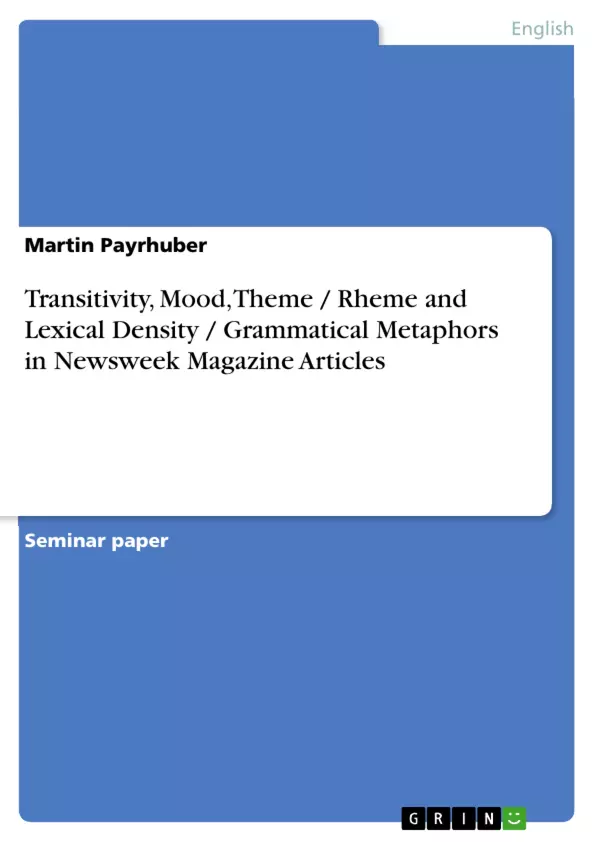The main reason for Michael A. K. Halliday, the “father” of systemic functional linguistics – and this report is based on functional linguistic analyses – to develop a new kind of grammar was that he saw the need to have a linguistic system that is more sociological in orientation. While Noam Chomsky, the most prominent of the so-called formal linguists, saw linguistics only as a means to describe the limits of language, Halliday and his fellow functional linguists are concerned with relating language to society, they try to figure out how the ways in which language is used have shaped its structure.
My goal in this analysis was to relate language to society in a practical example, I have tried to explore the differences between two journalistic articles of the same magazine, but taken out of different departments as far as the content is concerned. My question was, “Are there substantial differences in language between these articles?”
Inhaltsverzeichnis (Table of Contents)
- Introduction
- Material Chosen
- Methods
- Method A: FOG Index
- Method B: Ure's Lexical Density (LD)
- Method C: Halliday's Lexical Density (LD)
- Results
- Analysis of Theme / Rheme
- Analysis of Mood
- Analysis of Transitivity
- Analysis of Lexical Density and Grammatical Metaphors
- Conclusion
- References
- APPENDIX
Zielsetzung und Themenschwerpunkte (Objectives and Key Themes)
This analysis aims to explore the differences in language between two journalistic articles from Newsweek magazine, focusing on how linguistic features relate to the respective fields of politics and show business. The study utilizes systemic functional linguistics to investigate the interplay between language and society, examining how the structures of language are shaped by its use.
- Comparison of linguistic features across different journalistic fields
- Application of systemic functional linguistics to analyze textual structure
- Examination of lexical density and grammatical metaphors in different genres
- Exploration of the relationship between language structure and social context
- Analysis of transitivity, mood, and theme/rheme in journalistic discourse
Zusammenfassung der Kapitel (Chapter Summaries)
- Introduction: The introduction establishes the theoretical framework of the analysis, highlighting the importance of systemic functional linguistics and its focus on the social dimension of language. It outlines the goals of the study and introduces the two chosen Newsweek articles.
- Material Chosen: This chapter presents the specific Newsweek articles selected for analysis, emphasizing their distinct thematic areas of politics and show business. It clarifies the criteria used in choosing the articles and explains the rationale for selecting 100-word passages for comparison.
- Methods: This chapter outlines the methodologies employed in the analysis, drawing upon systemic functional linguistics theory and referencing specific frameworks. It details three methods used to assess lexical density (FOG Index, Ure's LD, Halliday's LD) and explains the inclusion of grammatical metaphors in the analysis.
- Results: This chapter presents the findings of the analysis, examining the themes, moods, and transitivity structures of the two articles. It includes a discussion of lexical density and grammatical metaphors, comparing the results between the political and show business texts.
Schlüsselwörter (Keywords)
This analysis examines key linguistic concepts such as transitivity, mood, theme/rheme, lexical density, and grammatical metaphors. It focuses on the differences in language structure between two journalistic articles from Newsweek, highlighting the distinct fields of politics and show business. The study uses the theoretical framework of systemic functional linguistics, emphasizing the relationship between language and society.
- Quote paper
- Martin Payrhuber (Author), 2001, Transitivity, Mood, Theme / Rheme and Lexical Density / Grammatical Metaphors in Newsweek Magazine Articles, Munich, GRIN Verlag, https://www.grin.com/document/54755



